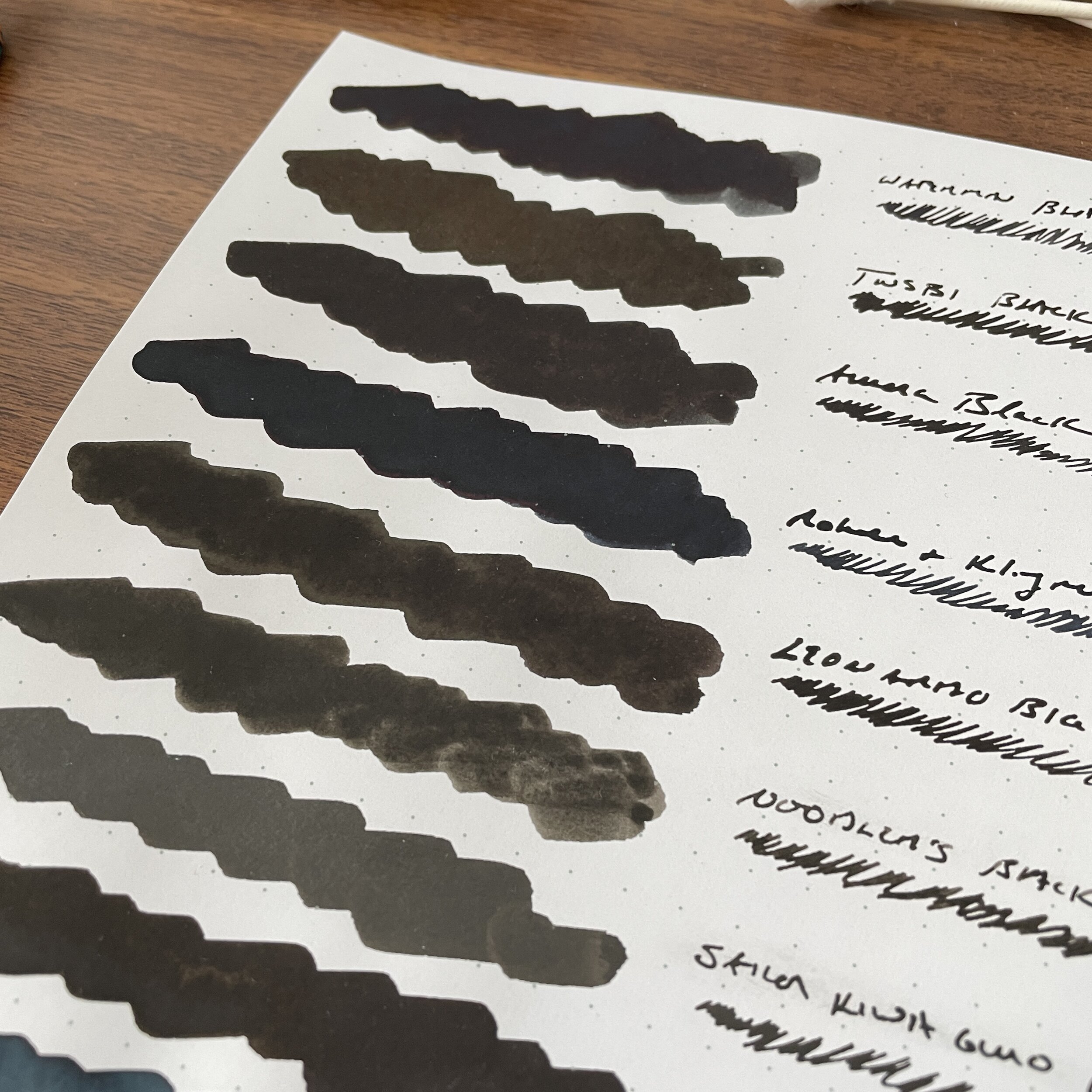For the last round of ink swabs, I grouped together the five color families of which I have the fewest colors: blacks, greys, browns, oranges, and golds. Of these five, I have the most black inks, followed by browns, then oranges, with greys and golds bringing up back end. What was interesting is that after swatching all of these various inks, the colors I like the most are the greys and the golds - inks I’ve discovered recently and plan to work into my primary rotation.
Key Takeaways and Conclusions
Black Inks. I always have appreciated, and continue to appreciate, a good black ink. But not a solid black, which I find boring. Most black ink enthusiasts know that black inks come in a variety of shades - some have blue, purple, or red undertones, and others dry to a matte finish. the closest ink to a “pure black” in my collection is classic Aurora Black, and while the color is a touch boring to me, it still gets a fair bit of use since it’s such a well-behaved, safe ink, especially for vintage pens. Other favorites include Waterman Black (red undertones), Lamy Black (purple undertones), and Roher & Klingner Leipzeiger Schwartz (blue-green undertones). Some people love Noodler’s Black and Sailor Kiwa-Guro for their waterproof qualities, but in my experience these black inks tend to smear since they are pigmented. I will likely keep the Kiwa-Guro for specific use cases since it smears the least.
Grey Inks. This is where things got interesting. For years, I found all of the grey inks I tried too thin and watery, with the writing barely legible on the page. Recently, however, I’ve discovered several that I enjoy quite a bit. Scribo Grigio is a dark grey with strong steel blue undertones. Vinta Armada is another multi-shader with a blue, green, and even red undertones, depending on the light, and Ferris Wheel Press Madam Mulberry is probably the best purple/grey I’ve ever used. (This latter ink could easily have been included in the purples as well, but since I only recently acquired it I had to group it here.) I don’t currently plan to get rid of any of my grey inks at this time. I’d also appreciate any suggestions for new greys to try!
Brown Inks. I strongly prefer dark brown inks, and pass on the lighter browns or reddish brown shades. Of this batch, I plan to keep the Montblanc Sand of the Desert (from the St. Exupéry collection), Scribo Classico Seppia, and Montblanc Toffee Brown. All of the others will go into the ink sale. I’ve really tried to get into brown inks but the color family, on the whole, just doesn’t appeal to me.
Orange Inks. Pelikan Edelstein Mandarin surprised me the most, with not only its color but its ability to shade. It’s a keeper, as are the legendary Sailor Jentle Apricot and Scribo Arancio di Sicilia. Diamine Deep Dark Orange is the perfect “blood orange” shade, and will stay in the collection for that reason. I’m still thinking on the others, but I doubt they will get enough use to justify keeping them even though they are great inks that survived prior orange ink purges.
Gold Inks. I only have two at the moment, and don’t know whether this category will continue to grow. The two inks I have I really enjoy: Vinta La Paz and Ferris Wheel Press Goose Poupon, both of which are gold inks that lean bronze (La Paz) and green (Goose Poupon). I typically go for darker golds, since they tend to be more legible. The number of colors in this particular range are somewhat limited, so I’m not sure there’s enough variety here that would justify accumulating more.
Ink Clearance Update and Further Reading
I plan to clear out excess inks that I don’t plan to keep in the same way I’ve been doing it. Watch the “Gently Used” Page in the coming days, as I cycle inks through the Patreon first and then move them over to the public page after a week. Some bottles still remain from my prior ink testing marathons, along with vintage pencils and office supplies that I’m clearing out. If you missed the earlier installments in this series, you can check them out below. My attention now turns to figuring out how to archive these posts for future reference, and how to update them.
For all of these ink samples, I’ve used standard q-tips to swab the inks, plus this glass dip pen to do the writing samples. The paper shown here is Write Notepads Dot Grid Memo Pad Paper, which as you can tell is exceptionally ink friendly and relatively inexpensive.
Disclaimer: This post does not contain paid affiliate links. Going forward, T.G.S is supported entirely by purchases from the T.G.S. Curated Shop and the T.G.S. Patreon Program, which offers access to online meetups, exclusive discounts and pre-orders, and more!

